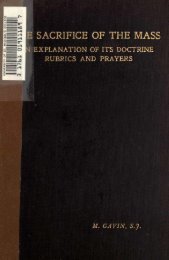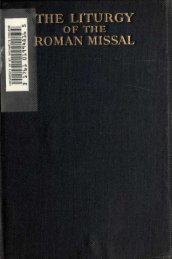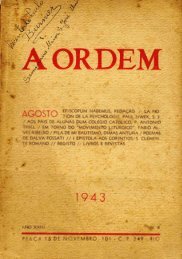E SACRIFICE OF THE MASS
E SACRIFICE OF THE MASS
E SACRIFICE OF THE MASS
You also want an ePaper? Increase the reach of your titles
YUMPU automatically turns print PDFs into web optimized ePapers that Google loves.
<strong>THE</strong> INTROIT. 37<br />
indeed two introductions to the Mass, general and<br />
special. The prayers before the Introit are the general,<br />
while the Preface forms the special introduction to the<br />
Canon, the fixed and more solemn portion of the<br />
Mass.<br />
Since the Introit begins the Mass, the priest makes<br />
as he recites it the sign of the Cross. In Masses for<br />
the Dead the sign of the Cross is made over the Missal ;<br />
it forms thus a suitable accompaniment to the Church s<br />
prayer for rest and light for the souls in Purgatory.<br />
The Introit consists nearly always of a passage<br />
from Holy Scripture with a verse of a Psalm and the<br />
Gloria Patri, after which the introductory passage is<br />
repeated. The Scripture passage forms an antiphon<br />
to the Psalm, which was formerly said entire. When<br />
the prayers of the Mass were shortened the first verse<br />
of the Psalm was retained often as an epitome of the<br />
whole.<br />
Le Brun and Benedict XIV. attribute the intro<br />
duction of Introits to Pope Gregory the Great, 590,<br />
others attribute the Introit to Pope Celestine L, 420.<br />
The Introit gives the key to the Mass. The<br />
character of the Mass is known by the Introit. Joy,<br />
sorrow, hope, desire, fear, gratitude, contrition, in<br />
and the Litany of the Saints, as the procession drew near to the<br />
Church. In the Station Church, before the celebration of the<br />
Holy Sacrifice, a homily was often delivered by the Pope.<br />
The Stations were usually penitential, though we find them also<br />
on joyful festivals, as in Easter Week, on the Ascension and<br />
Pentecost. The Catholic Dictionary (Sixth Edition, p. 857), quoting<br />
from Fleury, says that Gregory the Great marked these Stations,<br />
as we now have them in the Roman Missal. In the Office for<br />
that Saint on March lath, in the sixth lesson we find the following<br />
reference to the Stations: "Litanias, Stationes, et Ecclesiasticum<br />
officium auxit." (Dr. Gihr, The Holy Sacrifice of the Mass. English<br />
translation, pp. 377 379.)






